Key Takeaways: Liège-Bastogne-Liège 2025
Breaking down how Sunday's show of strength illustrates how Tadej Pogačar has boiled difficult one-day races down to a science
Across the brutal rolling hills of the Ardennes Forest, Tadej Pogačar once again proved why he’s the most dominant force in modern cycling by having his UAE team slowly asphyxiate the peloton before riding clear of a strung-out peloton on the legendary La Redoute climb, soloing to a resounding third career victory at Liège-Bastogne-Liège. With a clinical, almost to the point of looking casual, attack on the steepest slopes of the race's most iconic climb, the 26-year-old World Champion immediately distanced every rival, leaving Giulio Ciccone and Ben Healy to scramble behind in a desperate attempt to limit their losses and salvage a pair of well-earned podium spots. While the chase group fought valiantly, it was clear from the moment Pogačar surged that the race was over, and all that remained was a coronation ride back into Liège for one of the sport's greatest one-day talents.
Liège-Bastogne-Liège 2025 Top Ten
1) Tadej Pogačar (UAE Team Emirates-XRG) +0
2) Giulio Ciccone (Lidl-Trek) +1’03
3) Ben Healy (Education First) +1’03
4) Simone Velasco (XDS Astana) +1’10
5) Thibau Nys (Lidl-Trek) +1’10
6) Andrea Bagioli (Lidl-Trek) +1’10
7) Daniel Martínez (Red Bull-BORA-hansgrohe) +1’10
8) Axel Laurance (INEOS Grenadiers) +1’10
9) Thomas Pidcock (Q36.5 Pro Cycling) +1’10
10) Neilson Powless (EF Education-EasyPost) +1’10
Check out the defining points of the race, and my five key takeaways (expanded from my initial post-race thoughts) below:
BTP’s Spring Classics Coverage is brought to you by JOIN Cycling
The JOIN Cycling App is a smart training platform that adapts to your schedule, goals, and fitness level, offering dynamic, science-backed workouts. It’s perfect for cyclists of all levels, balancing training and recovery efficiently. With AI-driven adjustments and flexibility, JOIN helps you stay motivated and improve consistently. Redeem a free month through our special BTP link.
Liège Race Notebook:
BTP is seamlessly following every twist and turn of the 2025 Classics Season with the fantastic Tour Tracker app (iPhone/Android/Web)
132.2km-128km-to-go: Ineos attempt to turn the race on its head by sending Bob Jungels and Tobias Foss up the road to connect with the early breakaway, and, at least in theory, put pressure on UAE to hold the race together earlier than is ideal, which could leave them with fewer resources to set up a Pogačar attack later in the race.
79km: However, we can see that thanks to Domen Novak, Pavel Sivakov and Brandon McNulty, this move doesn’t bother UAE in the slightest, with the three support riders easily mowing down the Foss/Jungels escape, and pegging the breakaway back to within a minute, all while Pogačar stays out of trouble and protected from the wind behind his teammates.
35km: UAE is still on the front when they hit the steep climb of Côte de La Redoute, with EF expending significant resources to keep Ben Healy positioned ahead of the coming Pogačar attack, with Tom Pidcock glued to his wheel. Meanwhile, Remco Evenepoel is out of the frame and buried deep in the field. Considering just how critical positioning is heading into this climb, this means his race is over at this point.
34.8km: The race’s high-paced hibernation is finally broken when Pogačar casually rides off the front from a seated position. The steady, high pace from his UAE teammates has strung out the group to the point where his main rivals have some amount of distance between themselves and Pogačar’s wheels, meaning it is almost impossible to immediately respond. While he still has two teammates remaining, he correctly deduces that this extremely hard climb presents his best chance of getting away solo, and the risk of losing another reduced sprint only increases if he waits.
34.1km: Pogačar remains seated as the others scramble to respond behind. Eventually, Giulio Ciccone and Ben Healy break free from the logjam behind and follow Julian Alaphilippe, whose near-sprinting pace holds the gap to Pogačar under ten seconds.
32.4km-31.9km: Pogačar takes a slim ten-second lead over the top of the climb, but, unlike last year, where he immediately exploded the gap, gradually extends his lead as the chase group behind struggles to organize, with Remco Evenepoel attacking from the chase group.
24.2km-20.7km: Up front, Pogačar settles into a high pace and, unlike the past, appears focused on tucking into an aerodynamic position. This allows him to extend his gap to over a minute to the Healy/Pidcock/Alaphilippe/Ciccone chase group, with the Evenepoel-led peloton almost 90 seconds back.
12.7km: On the final climb of Côte de la Roche-aux-Faucons, Healy and Ciccone forge clear of the rest of the group while Evenepoel is dropped from the peloton and pulls off to the side of the road to avoid being filmed.
Finish: After pushing his gap to 1.5 minutes to the Ciccone/Healy chase group, Pogačar cruises through the final few kilometers as he soaks in his second Monument win of the 2025 season (and 9th of his career).
Chase Group Finish: Behind, Ciccone outsprints Healy as the duo barely hold off the chasing peloton to get well-earned podium spots.
Five Key Takeaways:
The first three takeaways are a slightly edited version of my initial post-race thoughts sent to premium subscribers directly after the race on Sunday
1) Tadej Pogačar Has His Winning Formula on Difficult One-Day Courses Down to Science: The 26-year-old World Champion won his third career Liège with a simple, yet effective, formula: Having his UAE team (in particular Domen Novak) sit on the front of the peloton setting an all-day hard pace that kept potential attackers from getting ideas and softened the legs of his rivals, so that when he launched his race-winning attack on La Redoute, even with teammates still remaining in the group, before soloing to the finish line to collect yet another Monument victory.
This might sound simple enough, and, as such, something other teams could account for, but when Pogačar is able to expend less energy by positioning himself perfectly throughout the race, and come into the most difficult climbs near the front, with multiple teammates on his wheel, it makes it incredibly challenging to respond.
However, it is worth noting that this strategy only works if you have the strongest rider in the race — which Pogačar almost always is. He fatigues at a lesser rate than his rivals due to the hard pace, leaving them without the explosiveness needed to respond when he launches his move. Add in Pogačar’s raw power, the difficulty of latching onto his wheel in the first place, and his ability to continue pushing a hard pace over the top of the climb, and it becomes clear why nobody stands a chance.
For example, while Pogačar’s seated move on La Redoute might have looked casual, his BTP-estimated average power for the entirety of the four-minute climb was 552 watts (8.4w/kg)/ 2,311 VAM, which means that he must have been pushing close to 800 watts for significant portions of his attack, a staggering amount considering they were over five hours into the race at this point.
But, the genius of Pogačar is that merely mimicking these numbers isn’t enough to follow his attack, since he is always positioned in the best spot, meaning when he goes, others have to ride harder than him to close down the initial gap, and he never goes too deep to ensure he has more left in the tank to slowly pry open the gap once getting over the top.
Progress of Pogačar’s Time Gap on the Chase Group:
35km (La Redoute attack): 0-seconds33km: 10 seconds
32km: 12 seconds
27km: 37 seconds
22km: 60 seconds
2.6km: 90 seconds
2) This Playbook Has Already Made Pogačar Possibly the Best One-Day Rider in the History of the Sport: The simple strategy from Pogačar and his UAE team has allowed him to rack up his 9th career Monument over just five seasons.
This win sees him yet again overtake Van der Poel for most amongst active riders (while being four years younger), and puts him tied at third all-time. Assuming he wins Il Lombardia at the end of the season, he will be only one behind Roger De Vlaeminck and eight behind Eddy Merckx’s record of 19, which was seen as unbreakable until just a few seasons ago.
He might only have one win in three attempts against Van der Poel so far in 2025, but those are in the two races (Milan-Sanremo and Paris-Roubaix) where Van der Poel has a massive physical advantage.
Until Van der Poel stops being as selective with his race starts, and starts challenging Pogacar at Lombardia and Liege, or beating him at Flanders, he, while still being the most potent Cobble Classic rider of all-time, has to be considered the inferior one-day rider (this is more due to the absurdity of Pogačar’s achievements than a criticism of Van der Poel).
And, with Pogačar averaging 1.8 Monument wins a season since taking his first at the 2021 edition of this race, he is on pace to pass Merckx by the end of the 2030 season. When we factor in the fact that he is now virtually guaranteed two Monuments per season by just showing up to Liège and Lombardia, the eventual catch could come far sooner.
In his last 16 Monument Finishes, Pogačar has racked up a staggering tally of nine wins, 13 podiums, and 16 top fives.
Pogačar’s Totals Through Last 16 Monument Finishes:
Wins: 9
Podiums: 13
Top Fives: 16
3) Remco Evenepoel Is Not Currently Up to the Challenge Tadej Pogaćar Is Throwing Down: While the idea of a true Pogačar/Evenepoel Ardennes rivalry looked realistic after last weekend’s Amstel Gold, after today, where Evenepoel never looked comfortable or well-positioned, never appeared as though he could challenge Pogačar, and even pulled off the road late in the race to hide from the TV cameras as they filmed him being dropped from the chase group, we are left with a fairly large dataset confirming that Evenepoel will likely never be a true one-day rival to Pogačar.
After all, Evenepoel has finished behind Pogačar in their last seven one-day head-to-head matchups in races where neither DNF’d, and hasn’t beaten Pogačar in a one-day race where both riders have finished since the 2022 World Championships, nearly three years ago.
Pogačar vs Evenepoel Head-to-Heads in One-Day Races 2023-2025
2025 Liège: Pogačar 1st vs Evenepoel 59th
2025 La Flèche: Pogačar 1st vs Evenepoel 9th
2025 Amstel Gold: Pogačar 2nd vs Evenepoel 3rd
2024 Il Lombardia: Pogačar 1st vs Evenepoel 2nd
2024 World Championship: Pogačar 1st vs Evenepoel 5th
2023 Il Lombardia: Pogačar 1st vs Evenepoel 9th
2023 World Championships: Pogačar 3rd vs Evenepoel 25th
But, more concerning than losing to a great rider today, Evenepoel suffered a full-on mental and physical collapse, just a few days removed from claiming he would have won Amstel Gold had he not crashed.
The complete deflation in Evenepoel’s confidence in the ten days between his win at De Brabantse Pijl and his meltdown today highlights the extreme streakiness that has defined his career so far, and just how much he relies on feeling at absolutely top form to stay with the front group and fight for position.
As the 2023 Vuelta showed us, one day he can be winning a summit finish, and the next he can be dropped on the first climb of a tough mountain stage, before going on to win two more stages.
With the bottom falling out of his form at consistent intervals, it would suggest that this issue is more mental than physical, and, if that is the case, he clearly lacks a key component that defines the riders who win nearly every major race in the modern version of the sport.
For example, this resilience factor is so important that since the end of the 2022 season, despite all being roughly on the same talent level, Mathieu van der Poel and Pogačar have combined to take 13 victories across the last 15 Monuments, with Evenepoel only grabbing a single one.
4) The Passive Tactics from Pogačar’s Rivals Are Easy to Criticize, But They May Present the Best Chance of Success Against the Near-Unbeatable Superstar: As Pogačar soled clear after ripping off the front of the group on the steep slopes of Côte de La Redoute, plenty of viewers and pundits raged at the fact that the top rival teams, like Lidl-Trek, had worked on the front to keep the pace high and group together on the lead-in to the climb, while only a single team, Ineos, attempted to shake things up with an ultimately-doomed attack.
While working with UAE might seem like a foolish thing to do considering Pogačar’s devastatingly effective track record in difficult one-day races with multiple available launch points (he hasn’t lost on a course one-day course with more than 3,500 meters of climbing since the 2022 World Championships), it also reflects the reality of the current situation, where the rest of the peloton realizes that a second or third behind Pogačar is as good as they could realistically do.
Ineos might be getting credit for their aggressive tactics, but their attempted two-man bridge to the breakaway with Tobias Foss and Bob Jungels between 127km and 82km-to-go, was never going to work due to the massive gap they would have had to close and the extremely high pace in the peloton behind.
Illustrating just how hard it is to mount any challenge to Pogačar on a course like today’s, even if the Ineos duo, plus a group of other outside contenders, had made contact with the breakaway, Pogačar could have just sat in the wheels as his uber-strong UAE team ate into their gap, and trusted that the kilojoules the attackers were forced to generate out front would see their gap crater in the series of brutal climbs inside the final 100 kilometers and leave them unable to respond when Pogačar came surging past.
Instead, the tactic of riding for the podium, and almost completely ignoring Pogačar, likely gives his rivals the greatest chance of winning since it leaves them ready to capitalize on a crash, bonk or mechanical issue (two of which have happened to him just this year), which have a far greater probability of occurring than correctly executing a long-range raid against the strongest team in the race.
It is also important to remember that for riders like Giulio Ciccone, who had a single Monument podium in his career prior to Sunday, and Ben Healy, who had never landed on the podium of a Monument, and only once at a top-tier one-day race, second and third place are a near-ideal outcome that fully justify the team’s work earlier in the day.
5) The Incredibly Difficult Course Has Made Liège-Bastogne-Liège a Far Less Exciting Version of Milan-Sanremo: When the course was changed prior to the 2019 edition away from the uphill finish in Ans and into central Liège, it was thought that the modification would open up the racing, and make it less of an uphill sprint contest.
For the first few years, this appeared to be the case, with thrilling reduced sprint finishes between the sport’s top GC contenders and one-day riders in 2020 and 2021. But, since Remco Evenepoel won in 2022 after attacking on La Redoute and soloing to the finish, the exact same formula has been used by the eventual winner (which has either been Evenepoel or Pogačar), in every successive edition.
This means the race has fallen into a Sanremo-esque rhythm, where the team of the pre-race favorite sets a steady pace on the front, while everyone else huddles in the slipstream in an attempt to preserve energy until the critical moment, which everyone knows will be on La Redoute, arrives.
But, unlike Sanremo, the finale of Liège is so hard that instead of kicking off a thrilling tactical battle among a handful of the sport’s top riders, it allows the strongest rider to simply ride clear for the win, while the rest quickly start racing for the coveted Monument podium spots on offer.

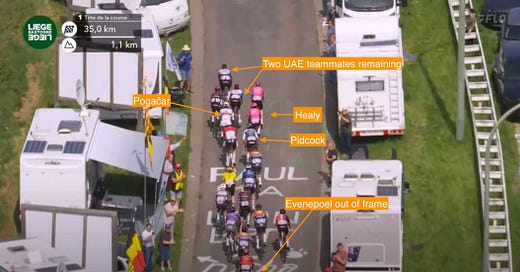








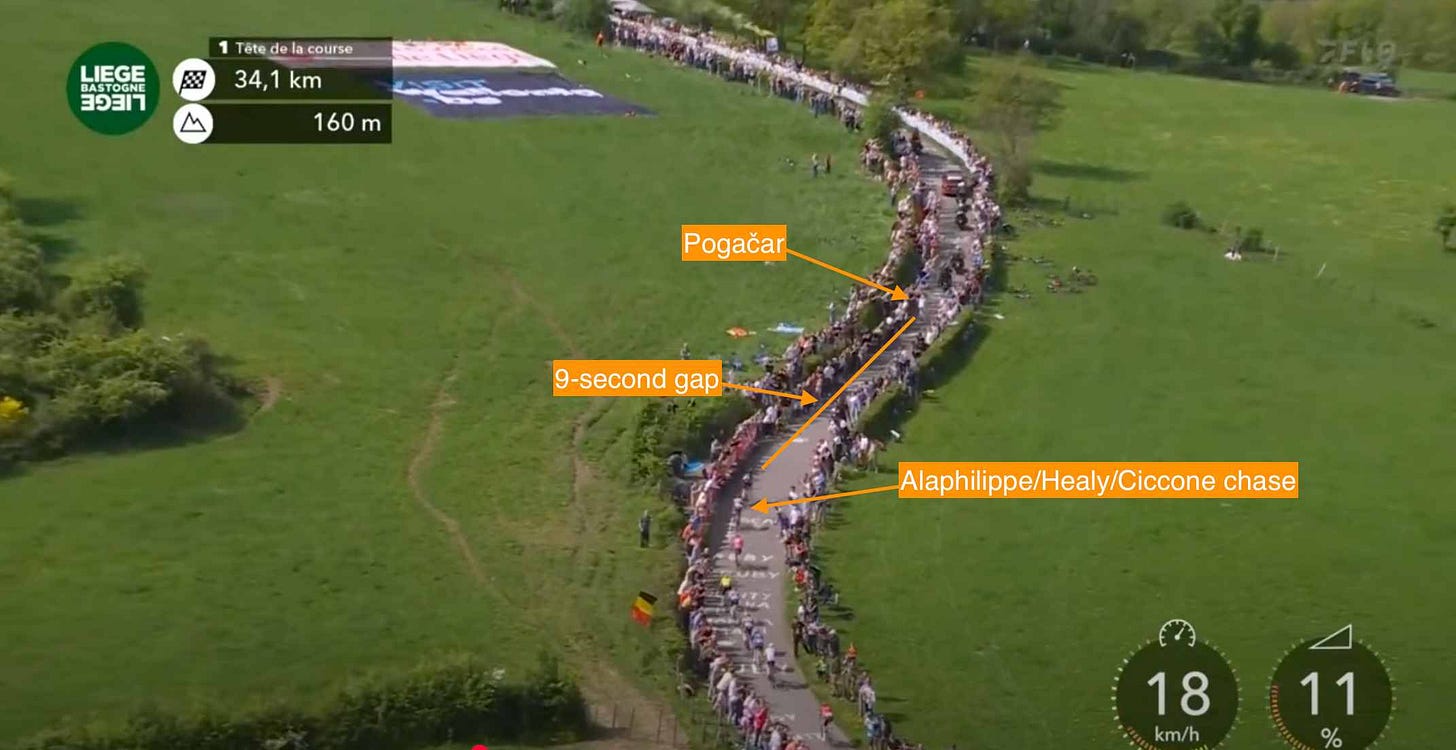
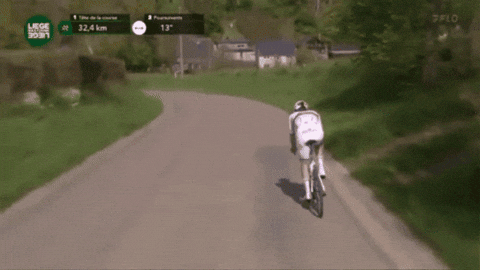
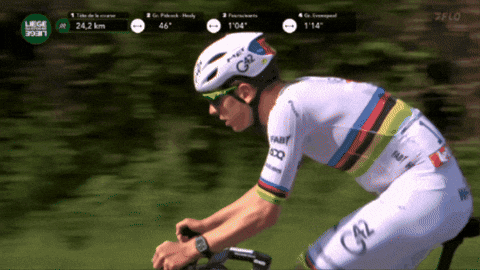


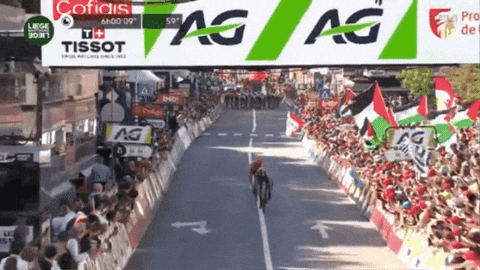
We are witnessing something unprecedented.
Putting out that kind of power throughout an attack that started a kilometer from the top is incredible. Five hours into what many consider the most difficult monument. Following La Flèche Wallone Johan Bruyneel said that if Pogacar regularly uses his team like he did in that race, that he is unbeatable. Lance Armstrong said: “We can compare this with other sports. You have for example the London Marathon. Here are the best cyclists of the world. In the London Marathon are the best marathoners in the world. This is the equivalent of winning the London Marathon by one minute. This is the equivalent of winning the Augusta Masters by 15 strokes. These are things you don't see. They are the best in the world. And every other week he does it."